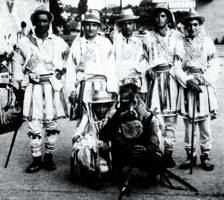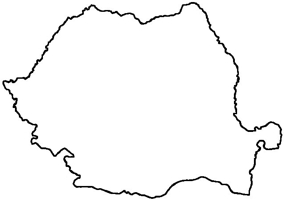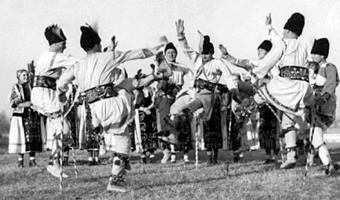
|
The Society of Folk Dance Historians (SFDH)
From the Village to the Stage:
[
Home |
About |
Encyclopedia | CLICK AN IMAGE TO ENLARGE |

|
In view of the intense industrialism and modernization in the south of Romania, one would hardly expect to encounter "Călușarii" any place other than on the stage or in the film archives.
 Călușarii are the ritually-closed group of seven, nine, or eleven male dancers who take part in the traditional Whitsuntide (the week following Whitsunday, aka Pentecost) custom, "Căluș." Originally, Căluș was a healing ritual that occurred during "Rusalii" (or Whitsuntide), fifty days after Orthodox Easter (Christian Pentecost). The ritual also provided the villages of the agrarian south protection from malevolent forces believed to be particularly dangerous and active during this period, as well as to assure the community fertility and fecundity for the ensuing year. This was accomplished by means of a series of dances and magical actions whose effectiveness derived from adherence to a deeply-rooted belief system.
Călușarii are the ritually-closed group of seven, nine, or eleven male dancers who take part in the traditional Whitsuntide (the week following Whitsunday, aka Pentecost) custom, "Căluș." Originally, Căluș was a healing ritual that occurred during "Rusalii" (or Whitsuntide), fifty days after Orthodox Easter (Christian Pentecost). The ritual also provided the villages of the agrarian south protection from malevolent forces believed to be particularly dangerous and active during this period, as well as to assure the community fertility and fecundity for the ensuing year. This was accomplished by means of a series of dances and magical actions whose effectiveness derived from adherence to a deeply-rooted belief system.
Briefly, the ritual formation of the Căluș group accompanied by stringent prohibitions with regard to their behavior during Rusalii temporarily separated by Călușarii from the realm of normal daily life. In turn, they were attributed supernatural powers that enabled them to serve as a communicative link between the community and, in particular, harmful supernatural beings. Faith in the Călușarii's powers was, and is, easily reinforced by their manifestation of extraordinary physical and psychological strength during the performance of the ritual. The vigorous and exciting dances accompanied by the driving, mesmerizing rhythm of the music, created an intense energy for both the Călușarii and the community. This energy was further heightened by the continual clicking of the dancer'ss "pinteni" ("spurs") and the furious jingling of the "clopote" ("bells") worn under their knees. The noise created by these spurs and bells was believed to help keep away evil spirits. Altogether, the combination of dynamic dance music, and magical actions within the framework of a complex belief system resulted in a powerful and necessary event for the continual well-being of the community.
 But as the conditions of life and work began to change, so did the Căluș. In Mehedinți and Dolj, where the ritual elements had been the strongest, Căluș has practically disappeared, although the underlying belief system has remained fairly intact. Driving through these two "județe" (administrative districts) on the Monday of Rusalii, we stopped and asked workers in the fields how they felt about working on a day in which, according to the tradition of Căluș, such work was prohibited. To our surprise, most people still wore garlic and wormwood in their belts, a ritually prescribed prophylactic action against the harm (in the form of a nervous illness) to which they were vulnerable for violating the work interdiction.
But as the conditions of life and work began to change, so did the Căluș. In Mehedinți and Dolj, where the ritual elements had been the strongest, Căluș has practically disappeared, although the underlying belief system has remained fairly intact. Driving through these two "județe" (administrative districts) on the Monday of Rusalii, we stopped and asked workers in the fields how they felt about working on a day in which, according to the tradition of Căluș, such work was prohibited. To our surprise, most people still wore garlic and wormwood in their belts, a ritually prescribed prophylactic action against the harm (in the form of a nervous illness) to which they were vulnerable for violating the work interdiction.
Another incident demonstrating the strength of the belief system occurred in the city of Craiova, Dolj. Groups of Călușarii come to the cities to perform in the streets and are, as in the village, reimbursed accordingly. In search of Călușarii in the city, we asked in the marketplace if they had been seen. "Of course, they went 'that way' about ten minutes ago. What's the matter, do you have someone sick?" Despite the fact that Căluș, and especially its healing aspect, rarely occurs in Dolj today, our hurried inquiry about the whereabouts of the Călușarii in the city provoked a spontaneous and natural reference to the illness that only they, the Călușarii, can cure. Why else would anyone be looking for them in a city? The belief is there, even though the currency of the practice is not.
In contrast to this general decay of the ritual in Mehedinți and Dolj, Căluș is, however, still widespread throughout Olt, Argeș, Teleorman, and other județe of the south. In thes areas, the custom has acquired an ambiguous status both ritually and within the belief system. What once was purely a ritual event has become more overtly a form of entertainment, although, again, the ritual significance has not necessarily vanished from the minds of the community. On the one hand, the group of Călușarii is still formed according to ritual acts and rules, people continue to invite them to "dance" in their courtyards to insure good health, luck, and plenty; women safe-keep, for medicinal purposes, the garlic and wormwood "danced" by the Călușarii and, these to be effective, must either be bought or stolen from the Călușarii. Also, it is interesting to note that, in general, the community considers "cures" to be within the domain of women's activities, but during Rusalii, only men possess the power to cure. The women still give their young children to the Călușarii to hold during the "big hora" dance so that they will grow up to be healthy and strong like their temporary protectors. Displaying a more modern orientation, one truck driver stopped and asked the Călușarii to dance in front of his truck so that he would be protected from possible accidents!
On the other hand, Căluș provides great amusement and entertainment for all. Certain transformations of the ritual components and of the dances have occurred that seem to account partially for the continued existence of this custom. For example, the healing now occurs metaphorically as a satirical death-resurrection play enacted by a mute figure and one or more of the Călușarii. This mute is a central character in the Căluș from these regions; one of his primary roles is that of the comic. In keeping with the times, the fertility and fecundity functions of the ritual are now sexually very blatant, usually being explicated through the theatrics of the mute, and/or the Călușarii. Thus, in every courtyard, the community can experience the excitement of the spectacular dances, the hilarious parody plays of the Călușarii, and the comic actions of the mute. It is a fine day for everyone!
As previously mentioned, Călușarii have long gone to the cities to entertain. For us, their performance in the city streets would be a highly developed form of street theater. They are also aware of this and do not seem to find it peculiar to dance ritually in the village and then go to the city the following day. Nor is it all strange to find Călușarii dancing on Rusalii in the village, the next day in the city, and the following weekend on the stage. The latter usually involves the dances only, which easily lend themselves to stage performance. In this context, the ritual has lost its meaning and Căluș has necessarily taken on a different significance. The spectacular virtuosity dances have been divorced completely from the custom, the dances continuing to utilize only certain ritual elements, such as, the bells, pinteni, and "strigăte" ("shouts") that, under any circumstance, accentuate the hypnotic rhythm and intensity.
Thus the Căluș dances have acquired an identity of their own, representing an almoset nationalistic aesthetic vitality. Practically every professional and amateur ensemble in Romania has its own version, highlighting the most dynamic and acrobatic movements of the dances. It is always a showstopper. At a performance last fall given by Rhapsodia, the ensemble in București, Romanian teenagers awaited Căluș almost as if it were the Beatles who were about to appear. When the suite was over, screaming girls rushed forward throwing roses on the stage. Căluș as a stage phenomenon is another topic. In this case, the dancers need not be ritual Călușarii. But what about the ritual Călușarii on stage?
Actually, the transition to the stage for Călușarii themselves began in earnest in 1935 when the group Padureți, Argeș, went to the International Folk Dance Festival in London. Imagine Călușarii traveling to London when most of them had never even been to București! They went and so began the serious appreciation of their dances outside of the ritual context. Perhaps the seeming psychological distance between performing in the village and on the stage in London was not really so unfathomable; they always danced before an audience. Did a few thousand more really matter, especially if the dancers were close to or in a trance state? Pertinent to their conception of audiences and themselves, I was told the following anecdote: on their way to London, the Călușarii arrived in Paris on Bastille Day. Naturally, there were thousands of French in the streets. It never occurred to the Călușarii that the French were there for any reason other than to see them! That was in 1935.
It is now 1977. The ritual has died out in some districts but still exists in many others. In these, Călușarii find themselves taking their ritual oath every year, making their flag, dancing in the village for "fun and (or) ritual." (The group from Vilcele was called upon to cure someone as recently as two years ago.) Then they go to the city to dance before the public at places such as train stations, the market, and the squares. They may then go to compete in festivals, the major one being the annual Călușarii festival in Slatina, Olt. Traditionally, when two groups of Călușarii met they fought to determine the stronger. Any deaths were not punishable by law. (Fighting was not specific to groups of Călușarii but also occurred in many ritual situations, such as in weddings or in the Macedonian Rusalia.) This later became transformed into a dance competition between the two groups, the villagers acting as judges. The best dancers won; the other group was then obliged to forego dancing in that village. Occasionally, they even had to forego the remainder of their ritual obligations, their power having been broken. Given this tradition, the annual Căluș festival surely must be the most exciting and intense for the groups of Călușarii, especially the ritual ones.
At the 1976 festival, there were twenty groups of Călușarii. Of these, fifteen groups had danced in their village the previous week on Rusalii. One group used to dance in the village but was unable that year because of work. The other groups were performance groups, having never danced in the villages; of these, at least two consisted of only children. Almost all of the Călușarii are workers in cooperatives or in factories, or are students. It was interesting to talk with them regarding their feelings aout dancing on the stage and in the village. Some said, "It's easier to dance in the village because in the village mistakes are tolerated" (in the dances), you can rest a little in the village because there we dance an entire suite in which the virtuosity figures are followed by walking figures, or we can rest when the mute does his comicry; it's less pretentious in the village." Some felt that there really wasn't any difference except that the mute was in the village and not usually on the stage.
Other Călușarii preferred to dance on stage and said that they danced on stage with as much conviction as in the village. Many groups simply liked performing before large audiences. The stage experience, however, is a more concentrated one, lasting only ten to twenty minutes and demanding that the dancers be very alert. Because of the intensity of the dancing because of the short time, the stage performance is, in a way, more tiring than dancing all day in the village. The "vătaf" ("leader") from Pădureți attributed this stage-tiredness to the fact that the dancers in this context are not bound by the ritual oath, thus, they do not possess supernatural powers. Călușarii from Siliștea Crucii, Dolj, agreed that they could dance three days during Rusalii and never tire, yet after fifteen minutes at a Sunday hora, they were exhausted. They too said it had to be connected somehow to the mysteries of the oath.
For the ritually-based groups, the intensity being Călușarii may be about the same on the stage as it is in the village in terms of the dance. The dance is still mesmerizing and dynamic on the stage. They "get into it." There is an evident strength, almost a frenzy, that comes forth. This feeling is not so apparent among the ensemble groups that only dance on stage.
Some groups attempted to integrate the mute into their stage performance, a task not easily accomplished. It is usually a failure if the group is only a performing group, meaning that the mute character does not have the experience of his role in actuality – the soul of it. It was interesting to watch a village group accompanied by their mute adjust to the dictates of varying contexts. Walking through the city early in the morning, we noticed a large crowd of people gathered in front of a store. One possibility for this gathering was that there was a group of Călușarii performing and, indeed, there was. The crowd was thoroughly involved in the antics of the mute and the Călușarii. The mute was equipped with his wooden sword, and a "traista" ("woven bag") in which he kept a red wooden phallus (this is traditional for the mute). The crowd, particularly the women, urged him to "show it again." Blatant as it is, there was no hint of pornography. It is simply a transformed expression of the ritual function of fertility in a contemporary context. "Death-resurrection" near a busy intersection was just as natural.
Later that afternoon, the group performed on stage. The mute was also there, but without the red phallus. Needless to say, someone's conception of city stage decorum influenced this, and it raises interesting questions regarding the groups' own attitudes. (In retrospect, I regret that didn't go back to them and ask if the decision was their own.) In any case, the fertility aspect was more disguised and ambiguous on stage. Nonetheless, the mute was obviously very experienced and talented and managed to carry ou this role on stage – including the death-resurrection play.
The differences between ritual village and/or street performance (in which there is direct audience involvement) and stage performance (in which there is not) are not easily bridged. Some groups succeed, many don't. Both situations require audiences. As the vataf from the group that went to London in 1935 reflected (fall, 1975); "On the stage, Căluș is also a type of s pectacle; however, in the village, Căluș was a ritual tradition." What he meant was that Căluș is really only Căluș, and Călușarii are really only Călușarii during Rusalii. At any other time, it is a different type of experience and has to be because they only have their magical power during Rusalii. Given, however, that the Căluș dances are so spectacular, they have generated a magic of their own on stage. The Călușarii's fluidity between the village, city, and stage contexts will probably assure that they will never completely disappear in these areas of Romania. Their vitality results from a complex process of continual transformation and adaptation.
DOCUMENTS
- Romania, a country.
- Romania's Călușarii, an article.
Used with permission of the
Center for Traditional Music and Dance Archive, www.ctmd.org.
Printed in Balkan-Arts Traditions, 1977.
This page © 2018 by Ron Houston.
Please do not copy any part of this page without including this copyright notice.
Please do not copy small portions out of context.
Please do not copy large portions without permission from Ron Houston.